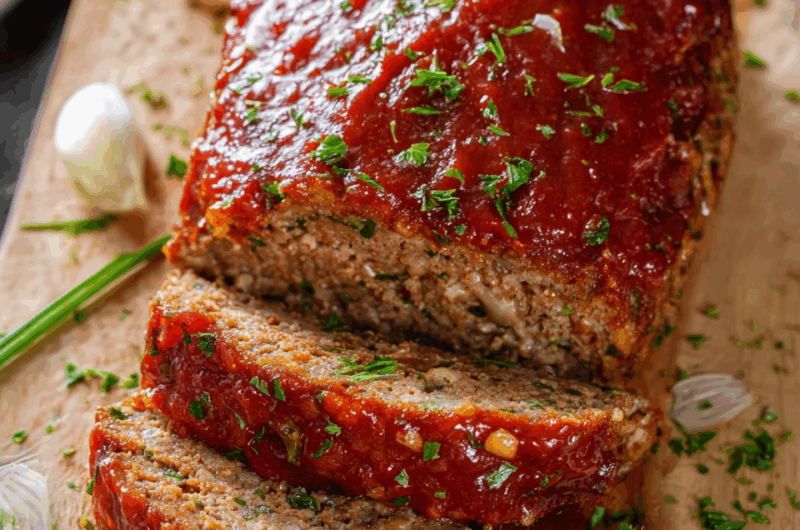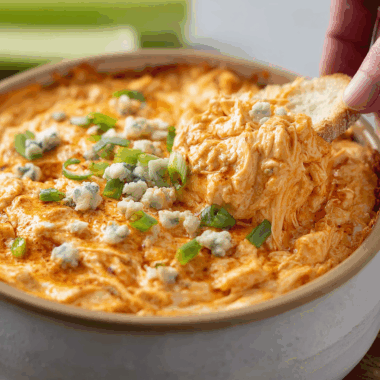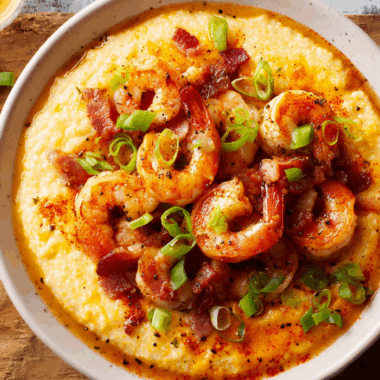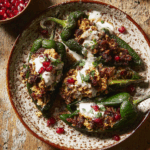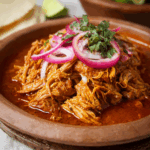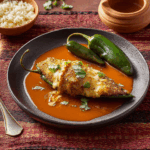The beauty of this classic meatloaf lies in its simplicity. Made with juicy ground beef, aromatic garlic and onions, and bound together with breadcrumbs and milk, this dish is elevated by a tangy-sweet glaze that caramelizes to perfection in the oven.
Whether it’s a Sunday dinner or a weeknight meal, this meatloaf offers a nostalgic comfort and rich flavor in every bite. Serve it alongside mashed potatoes and roasted vegetables for a satisfying, hearty plate that feels like home.
Full Recipe:
-
2 lbs ground beef (80% or 85% lean)
-
1 medium onion (1 cup), finely chopped
-
1 tsp olive oil
-
2 large eggs
-
3 garlic cloves, minced
-
2 Tbsp ketchup
-
3 Tbsp fresh parsley, finely chopped
-
3/4 cup Panko breadcrumbs (or gluten-free option)
-
1/3 cup milk
-
1 tsp salt
-
1 tsp Italian seasoning
-
1/2 tsp ground black pepper
For the Glaze:
-
3/4 cup ketchup
-
1 ½ tsp white vinegar
-
2 Tbsp brown sugar
-
1/2 tsp garlic powder
-
1/2 tsp onion powder
Directions:
-
Preheat oven to 350°F and line a rimmed baking sheet with parchment paper or foil.
-
In a skillet, heat olive oil over medium heat. Add chopped onion and sauté for 5-7 minutes until golden. Let cool slightly.
-
In a large bowl, combine beef, sautéed onions, eggs, garlic, ketchup, parsley, breadcrumbs, milk, salt, Italian seasoning, and black pepper. Mix until just combined – avoid overmixing.
-
Shape the mixture into an 8x4x3-inch loaf on the prepared baking sheet.
-
Bake for 40 minutes.
-
While baking, mix all glaze ingredients in a bowl.
-
After 40 minutes, spread glaze over the meatloaf. Return to oven for an additional 20 minutes or until internal temperature reaches 160°F.
-
Let meatloaf rest for 10-15 minutes before slicing.
Prep Time: 15 minutes / Cooking Time: 1 hour / Total Time: 1 hour 15 minutes
Kcal: 338 kcal / Servings: 8 servings
The Ultimate Comfort Dish: Meatloaf Like Grandma Used to Make
When it comes to timeless American comfort food, few dishes compete with a well-made meatloaf. It evokes memories of home-cooked family dinners, warm kitchens, and satisfying plates served with mashed potatoes and green beans. This particular meatloaf recipe, inspired by the much-loved version from Natasha’s Kitchen, brings together all the nostalgic flavors you remember—with modern updates that enhance texture, flavor, and presentation.
With its tender, juicy interior and signature caramelized glaze, this meatloaf isn’t just a retro favorite—it’s a weeknight hero. Whether you’re feeding a large family, meal-prepping for the week, or simply craving a slice of cozy comfort, this dish delivers every time.
Why This Meatloaf Stands Out
Not all meatloaves are created equal. This version has become a go-to for thousands because it prioritizes both moisture and flavor without overcomplicating the preparation. By incorporating sautéed onions, fresh parsley, and a tangy-sweet glaze, the dish transforms from bland and dry to rich and crave-worthy.
A common complaint about traditional meatloaf is that it can be dense or lacking in flavor. This recipe corrects that with a few key culinary principles: balancing fat content in the meat, using milk-soaked breadcrumbs for tenderness, and incorporating eggs and ketchup to bind and enrich the mixture. The real showstopper is the glaze—ketchup-based with vinegar, brown sugar, and a touch of spice, which turns into a sticky, flavorful topping after baking.
The Secret Behind the Glaze
A good meatloaf glaze isn’t just a finishing touch—it’s the crown jewel of the entire dish. Too often, meatloaves are baked with either a too-thin glaze that runs off or an overly sweet layer that overpowers the meat. Here, the glaze is thick and balanced with acidity and sweetness. The ketchup provides a tomato base, the vinegar cuts through the richness of the meat, and the brown sugar caramelizes during baking for an irresistible finish.
One of the unique aspects of this recipe is the timing of the glaze application. Instead of smothering it at the beginning (which can result in burning or sogginess), it’s added halfway through the bake. This allows the surface of the meatloaf to form a slight crust and gives the glaze something to adhere to, maximizing flavor and presentation.
Free-Form vs. Loaf Pan: Why the Shape Matters
Traditionally, meatloaf is baked in a loaf pan, but this method often results in uneven cooking, excess moisture retention, and a soggy bottom. The updated approach used here is to bake the meatloaf “free-form” on a parchment-lined baking sheet. This not only ensures more even heat distribution but also encourages crispy edges and better overall browning. Plus, cleanup becomes far easier.
Free-form meatloaf also allows the glaze to run over the sides slightly, creating a delicious crust on all surfaces. It’s aesthetically more appealing and less prone to that “steamed” texture that can occur in confined pans.
Meal Prep Perfection and Leftover Gold
One of the most practical aspects of this meatloaf recipe is how well it lends itself to make-ahead preparation and leftovers. You can assemble the loaf one to two days ahead and store it tightly wrapped in the refrigerator. When ready to cook, simply bring it to room temperature for 15–20 minutes and bake as directed.
Cooked meatloaf also stores beautifully. In fact, many fans argue that the flavor improves the next day. Keep it in an airtight container in the fridge for up to four days. Reheating in the oven or air fryer retains moisture and texture better than microwaving.
As for leftovers, they’re incredibly versatile. Meatloaf sandwiches are an obvious choice (especially with extra glaze spread on the bread), but you can also crumble leftover slices into pasta sauces, tacos, or breakfast hash. The hearty nature of the loaf ensures it holds up across multiple meals without falling apart.
Customization and Variations
While the base recipe is a classic, it’s also endlessly adaptable. Prefer a different protein? You can swap half the beef for ground turkey, pork, or even Italian sausage for a spicier flavor. Want it gluten-free? Substitute gluten-free breadcrumbs. You can even go dairy-free by omitting milk or replacing it with a plant-based alternative.
Other popular variations include adding chopped bell peppers for sweetness, shredded carrots for texture and nutrition, or cheese cubes for a melty surprise in the center. While these aren’t necessary for success, they give home cooks the flexibility to tailor the dish to their family’s preferences or dietary needs.
Why Families Love This Recipe
There’s a reason this meatloaf recipe has earned thousands of five-star reviews online. It’s dependable, accessible, and deeply satisfying. The ingredients are pantry staples, the prep is minimal, and the results are consistent. Even picky eaters often change their minds after one bite.
What’s more, it’s a dish that appeals across generations. Kids love the sweetness of the glaze, adults appreciate the complex flavors, and older generations feel a nostalgic pull toward a meal they may have grown up with. It also has a budget-friendly ingredient list, making it ideal for families looking to save without sacrificing taste.
Serving Suggestions to Complete the Meal
To round out your meatloaf dinner, pair it with sides that complement its richness. Mashed potatoes are the gold standard—creamy, buttery, and perfect for catching extra glaze. Roasted broccoli or asparagus adds a fresh, slightly bitter contrast to balance the meat’s umami. A crisp Caesar or coleslaw works well for a cool, crunchy side.
If you’re in the mood for comfort-on-comfort, baked mac and cheese makes an indulgent pairing. For something lighter, opt for a simple green salad with a vinaigrette to cut through the meatloaf’s richness.
Tips for First-Time Meatloaf Makers
If you’re new to making meatloaf from scratch, keep these quick tips in mind:
-
Use the right meat blend. An 80% or 85% lean ground beef strikes the right balance between flavor and moisture.
-
Don’t overmix. Combine the ingredients until just blended. Overworking the mixture can make the loaf dense and tough.
-
Rest before slicing. Let the meatloaf rest for 10–15 minutes after baking. This allows juices to redistribute and prevents it from falling apart.
-
Monitor internal temperature. Always aim for 160°F using a meat thermometer for ground beef. This ensures it’s cooked through without drying out.
A Tried-and-True Favorite Worth Repeating
At a time when so many people are returning to home-cooked meals and traditional recipes, this meatloaf offers both familiarity and excellence. It proves that you don’t need fancy ingredients or complicated steps to create a memorable dish. You just need the right balance of technique, flavor, and a little patience.
Whether you’re cooking for a crowd or making meals for the week, this meatloaf earns its place at your table. With thousands of positive reviews and personal stories behind it, it’s more than just a recipe—it’s a celebration of tradition and taste.
Conclusion: A Meatloaf Recipe You’ll Actually Crave
In today’s fast-paced world, it’s comforting to return to dishes that remind us of simpler times. This meatloaf is just that—humble in origin but rich in satisfaction. With its juicy interior, deeply flavorful glaze, and adaptability for modern preferences, it has become a staple in kitchens across the country.

